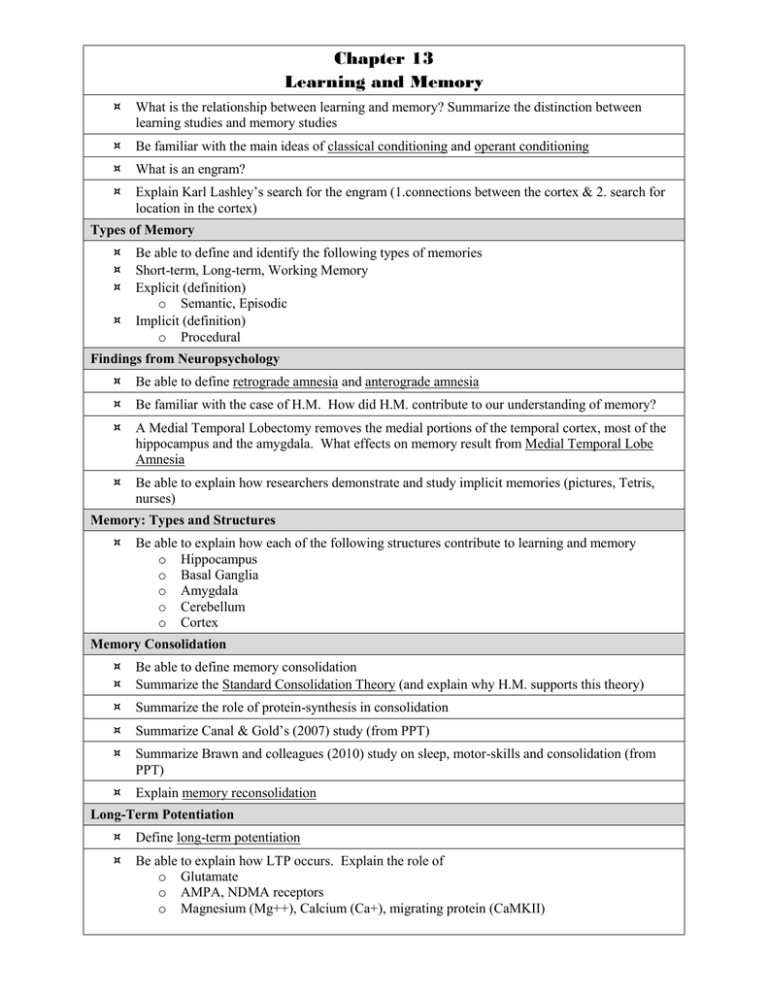Chapter 13 Learning and Memory
advertisement

Chapter 13 Learning and Memory ¤ What is the relationship between learning and memory? Summarize the distinction between learning studies and memory studies ¤ Be familiar with the main ideas of classical conditioning and operant conditioning ¤ What is an engram? ¤ Explain Karl Lashley’s search for the engram (1.connections between the cortex & 2. search for location in the cortex) Types of Memory ¤ ¤ ¤ ¤ Be able to define and identify the following types of memories Short-term, Long-term, Working Memory Explicit (definition) o Semantic, Episodic Implicit (definition) o Procedural Findings from Neuropsychology ¤ Be able to define retrograde amnesia and anterograde amnesia ¤ Be familiar with the case of H.M. How did H.M. contribute to our understanding of memory? ¤ A Medial Temporal Lobectomy removes the medial portions of the temporal cortex, most of the hippocampus and the amygdala. What effects on memory result from Medial Temporal Lobe Amnesia ¤ Be able to explain how researchers demonstrate and study implicit memories (pictures, Tetris, nurses) Memory: Types and Structures ¤ Be able to explain how each of the following structures contribute to learning and memory o Hippocampus o Basal Ganglia o Amygdala o Cerebellum o Cortex Memory Consolidation ¤ ¤ Be able to define memory consolidation Summarize the Standard Consolidation Theory (and explain why H.M. supports this theory) ¤ Summarize the role of protein-synthesis in consolidation ¤ Summarize Canal & Gold’s (2007) study (from PPT) ¤ Summarize Brawn and colleagues (2010) study on sleep, motor-skills and consolidation (from PPT) ¤ Explain memory reconsolidation Long-Term Potentiation ¤ Define long-term potentiation ¤ Be able to explain how LTP occurs. Explain the role of o Glutamate o AMPA, NDMA receptors o Magnesium (Mg++), Calcium (Ca+), migrating protein (CaMKII) ¤ Be able to summarize the changes that can occur in the presynaptic neuron o Action potential level o Release of glutamate o Expansion of axons o Transmitter release from additional sites The Hippocampus and Spatial Memory Be able to summarize the evidence for why the hippocampus is important for spatial memory What did the rats running down the runway indicate? What do fMRI and PET scan studies from humans and London taxi drivers indicate? What do MRI studies of London taxi drivers indicate? Chapter 14 Lateralization of Function Consciousness and Attention Lateralization of Function Define lateralization Be familiar with the three major commissures: corpus callosum, anterior commissure, hippocampal commissure Be familiar with the left-hemisphere dominance tasks, and right hemisphere dominant tasks Consciousness and Attention Be able to define consciousness and attention Be able to explain how brain activity is related to consciousness Be able to summary the following studies: o Crick and Koch (2004) – word priming (from PPT) o Macaluso, Frith, & Driver (2000) – attention and brain region (from PPT) What is binocular rivalry? How does it help us understand consciousness? Explain consciousness as a threshold phenomenon Explain the research that indicates that meaning of stimulus can be processed on a nonconscious level Explain the phi-phenomenon and its implications of consciousness NYTimes Article: Could Conjoined Twins Share a Mind? 1. 2. 3. 4. What part(s) of the brain do the twins share? What is the evidence that the Twins are able to share sensory information What is the evidence that the twins are able to share a consciousness (thoughts) Based on the information we have learned about the nature of consciousness do you think the twins will be able to share a consciousness?




